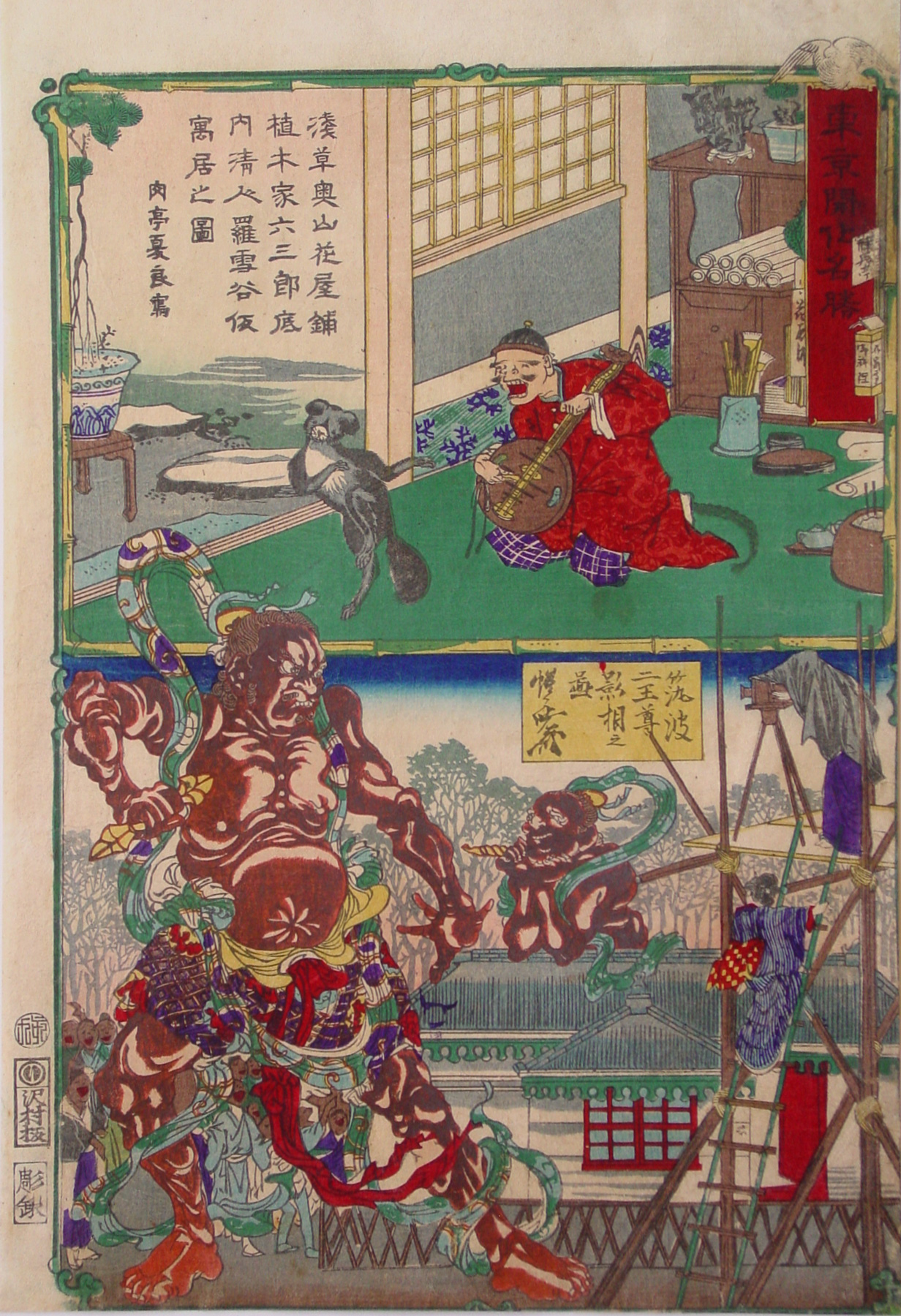About This Print
Source: Competition and Collaboration: Japanese Prints of the Utagawa School, Laura J. Mueller, Chazen Museum of Art in association with Hotei Publishing, 2007, p. 178-179."In this print from the series Famous Views of Modern Tokyo, Kyōsai collaborated with an unknown artist. [This "unknown artist" who signed this work 肉亭夏良写 Nikutei Karyō sha is now known to be Nikutei Karyō which was a pseudonym used by Kobayashi Kiyochika (1847-1915) early on in his career.] The signature in the left side of the upper scene is currently the only clue to his or her identity.1 Kyōsai's contribution on the bottom half of the print shows a comical scene from the entrance at the main hall at Asakusa Temple. The entrance area at this specific temple that includes a pair of guardian gods called Niō is known as Okuyama.
Kyōsai provides a humorous commentary on a photography studio that opened in this area in 1870. In Kyōsai's design, a photographer is positioned on a raised platform taking the portrait of one of the guardian gods, who is holding his standard ferocious pose. The photographer's assistant stands attentively on the ladder below him. The other god from the pair appears captivated by the scene as he leans over the main hall with his elbows resting on the rooftop and his hands tucked under his chin. The visitors to the temple stand under the imposing god looking and pointing upward under his short garment worn around his waist. The upper scene designed by the unknown Karyo [Nikutei Karyō, a pseudonym of Kobayashi Kiyochika (1847-1915)], includes an entertaining episode of a Japanese man in Chinese costume playing a traditional Chinese instrument as a gray dog dances on his hind legs to the music. The setting is the interior of a scholar's study complete with scrolls and brushes for writing and painting."
Perhaps the comic relationship of the two scenes is that of the dog performing for the minstrel and the Niō posing/performing for the photographer. The inscription on the top panel mentions the Okuyama Florist Shop in Asakusa ( 浅草奥山花屋).
Depictions of Niōs as entities come to life are frequent and the 16th century sculptor Hidari Jingoro was said to be so skilled that he could make his sculptures come to life. Hidari Jingoro was a favorite character of Kyōsai's, as in the below example of the collaborative print he did with Utagawa Kunisada I (1786–1865) titled The Actor Nakamura Utaemon IV as the Sculptor Hidari Jingoro Carving a Niō Statue, 1864.2
The Actor Nakamura Utaemon IV as the Sculptor Hidari Jingoro Carving a Niō Statue, 1864
image source: Carnegie Museum of Art 89.28.917
1 We now know the signature reads 肉亭夏良写 Nikutei Karyō sha which was a pseudonym of Kobayashi Kiyochika (1847-1915) used early on in his career.
2 The Art of Kawanabe Kyosai: Demon of Painting, Timothy Clark, British Museum Press, 1993, p. 59.
About The Series "Famous Places of Enlightened Tokyo"
Source: Time Present and Time Past: Images of a Forgotten Master: Toyohara Kunichika (1835-1900), by Amy Reigle Newland, Hotei Publishing, 1999, p. 40.
Published in 1874-75 by Sawamuraya (Takegawa Seikichi), the series comprises nineteen harimaze-e (a print incorporating various images on one sheet). Kyōsai contributed a number of images to the series along with Toyohara Kunichika (1835–1900), Kunichika's student, Toyohara Chikayoshi (fl. 1870s-1880s), Utagawa Hiroshige II (1826-1869) and Utagawa Yoshitora (fl. c. 1836-1882).
Print Details
| IHL Catalog | #375 |
| Title or Description | The Entrance of Asakusa Temple: Taking a Portrait of the Niō Guardians top half:「浅草奥山花屋鋪植木家六三郎底内清人羅雪谷仮寓居之図」 bottom half:「筑波二王尊影相之図」 |
| Series | Famous Views of Modern Tokyo (also seen translated as Famous Places of Enlightened Tokyo) 東京開化名勝 Tōkyō kaika meishō |
| Artist | Kawanabe Kyōsai (1831-1889) |
| Series | Collection of Famous Views of Modern Tokyo (also known as Famous Places of Enlightened Tokyo) Tokyo kaika meisho no uchi |
| Signature |  惺々暁斎 Seisei Kyōsai 惺々暁斎 Seisei Kyōsai Nikutei Karyō was a pseudonym of Kiyochika used early on in his career. [source: 浮世絵文献資料館http://www.ne.jp/asahi/kato/yoshio/kobetuesi/kiyotika-kobayasi.html "肉亭夏良もその始め頃の仮号であるといわれている。" |
| Seal of the Artist | not present |
| Publication Date |  |
| Publisher |  い 沢村板 I, Sawamura han [Marks: pub. ref. 459; seal 21-006] |
| Carver |  |
| Printer | |
| Impression | excellent |
| Colors | excellent |
| Condition | good - trimmed to image on right margin, not backed |
| Genre | ukiyo-e; harimaze-e |
| Miscellaneous | |
| Format | oban |
| H x W Paper | 13 7/8 x 9 1/4 in. (35.2 x 23.5 cm) |
| H x W Image | |
| Collections This Print | Kawanabe Kyosai Memorial Museum; Chazen Museum of Art 2004-41; Tokyo Metropolitan Library 035-C002-016 |
| Reference Literature | Competition and Collaboration: Japanese Prints of the Utagawa School, Laura J. Mueller, Chazen Museum of Art in association with Hotei Publishing, 2007, p. 178-179, pl. 167; The Omiya Bonsai Art Museu, Saitama E-147 |
last revision:
7/27/2021
5/22/2021



